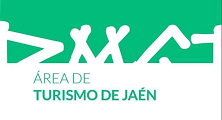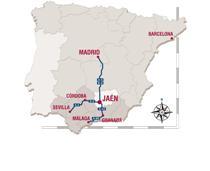Monograph- The Jewish community of Jaén
The
Jewish Community of Jaén
A ride through
the Jewish history of Jaén
* Route designed by IUVENTA Association and edited by the Tourism Council of Jaén
This route through the Jewish history of the city offers visitors the experience of a touristic and cultural itinerary along the areas inhabited by this medieval community (the Jewry) and other places of the historical sites of the city connected to the Hebrew population. The visitor is also offered the opportunity to explore, at the same time, other monuments of historical and artistic interest that the visitor will find along the street during the route.
1
FROM SANTA MARIA SQUARE TO MAESTRA STREET
We propose a route around Jaén’s Jewry which begins in the popular square of Santa Maria, at the impressive Cathedral that was built according to the traces of Andrés de Vandelvira. This cathedral is considered to be one of the finest examples of the Spanish Renaissance and is currently a World Heritage candidate. It is one of the most beautiful cathedrals in Spain and is closely linked to the persecution suffered by the converted Jews of Jaén in different historical periods. In the same square we find the Episcopal Palace and the City Council that symbolizes the centre of the municipal power. The tunics of the prisoners of the inquisition, called “Sambenitos”, were exhibited in one of the chapels of the former gothic Cathedral. “The Cleanliness of Blood” Statutes were thought up in a meeting by the Chapter of the Cathedral and they became widespread through the Empire after their approval by the Cardinal Silice in 1547 in Toledo’s Cathedral. These statues were aimed at forbidding access to some professions and to those who did not certify their condition of “Old” Christians, which meant that they do not have Arab or Jewish ancestry. It is worth visiting the inside of this large temple which was conceived as a huge reliquary to house the sacred relics of the Holy Face and other precious treasures. In the choir stalls we can find images of scenes of the New Testament, there are several images of Jews wearing a rodela, a circular symbol that they had to wear on their breast in some periods of the Middle Ages as a discriminatory symbol. The external façade of the sanctuary of the Cathedral preserves a gothic frieze representing the Jews as a cursed community that could only be saved through baptism and the Catholic faith (according to a discourse from the very beginnings of the 16th century). This frieze was built in a political and territorial context highly influenced by Jaén’s Inquisition. In fact, the Cathedral was the residence of Diego de Deza and Alonso Suarez; they both were Bishops of Jaén, but at the same time they had accepted the position of General Inquisitors. It is known that at the end of 1502, the “Council of the General Inquisition”, which was the highest collegiate body of the Inquisition, held its meetings in the house of the Bishop of the city. Finally, it must also be pointed out that the Acts of Faith of the Tribunal of the Inquisition were carried out in Santa María Square. The Tribunal was founded in 1483, becoming the third in Spain (after those of Sevilla and Córdoba) due to the high number of Jewish converts that had inhabited the city. Continuing along Maestra Street, on the right-hand side, we can find a beautiful niche with a crucified Christ, popularly known as “Christ of Amparo”; he was supposed to have appeared in this place when a group of Jews tried to desecrate a procession that was parading towards the Cathedral.
Maestra Street was the main commercial centre of the city until a few decades ago; it was the area where people of Jewish origin located their shops, offices and businesses. It is interesting to walk along the little streets that we can find around Maestra Street, especially the evocative street of the Arch of El Consuelo, a blind alley typical of the middle ages in which we can find some of the most popular tascas (taverns) of the city. Focussing on Maestra Street, we can find a building that houses the current Municipal Palace of Culture. This palace was the old residence of Miguel Lucas de Iranzo, baron, count and constable of Castile in the times of Henry VI. Some scholars point to the possible Jewish-convert origin of the Constable. One piece of evidence, amongst others, is that he did not work on Saturdays, a fact that can be related to the Shabat of the Jews. The Constable was murdered in the Cathedral on the 21st March 1473 by some “Old Christians,” and some scholars think that this murder was possibly due to his defence of the Jewish-convert cause. Within the palace, it is important to highlight the remains of the “Mudejar Room”, an artistical, historical monument with a beautiful wainscoting where the constable met with his court. In front of the main door of the Constable’s Palace we can find Madre de Dios Street, which we climb up to reach San Lorenzo’s Arch. This arch was a former homonym parish church in a Gothic style. It is a little church with a great deal of history. In the former San Lorenzo’s parish church the popular painting of “Cristo de la Tarima” was held, which was exhibited to satisfy the popular devotion. This canvas was related to a legend which harms the image of the Converted Jewish community who, as stated above, had their business centre located on Maestra Street. The arch of San Lorenzo is a National Monument. Inside, a special mention should be given to the chapel on the ground floor, which has beautiful Arab plasterwork and tiles. Juan de Olid, secretary of the constable, and his wife Isabel Rendelez were buried inside the chapel. Nowadays, the building is headquarters of the Cultural association “Amigos de San Antón.” Returning to Maestra Street, we will continue towards the old Jewish quarter walking along Martínez Molina Street.
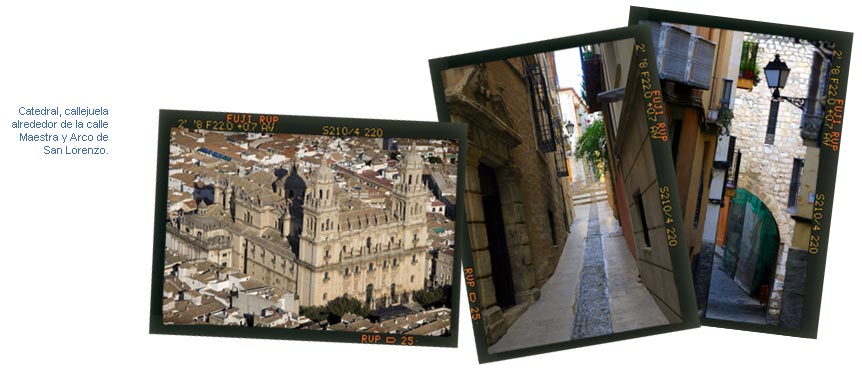
2
THE JEWISH QUARTER
Continuing our tour, on the left we arrive at San Andrés Street. Now we will enjoy visiting the historical centre of the old city, which the Jews inhabited and was called the “Judería”. Walking down this street we find the façade of San Andrés church that was possibly an old synagogue, as we can see by the beautiful pointed horseshoe arches on the inside, which are very similar to the arches of other Spanish synagogues. The sobriety of San Andrés façade seems to evoke memories of the medieval regulation that forced the Jewish to build their synagogues in an austere style to distinguish them from the churches of the city. The eastern-orientation of the temple, the secluded courtyard, etcetera, appear to confirm that it was one of the old medieval synagogues of Sepharad. The absence of a monumental façade at the base of the temple shows that the entrance and the exit of the medieval synagogues were located on the side walls, this way no one could turn their back to the eastern wall when leaving the temple; the place where the tabernacle is located, which contains the Torah scrolls (Jewish Law). Attached to the temple, we find some rooms that belong to a brotherhood called “Limpia Concepción de nuestra Señora.” We find the “Saint Chapel” placed at the foot of the church. This chapel belongs to the aforementioned brotherhood and it was built long after the synagogue. Worthy of mention is the magnificent grille that closes the chapel, a work by the master Bartolomé, one of the jewels of the wrought iron-work in Andalusia. To discover the Jewish quarter we can continue along Gato Alley, from here we can access a group of little streets; only three of them have outdoor access. Nowadays, some of them can not be visited because they are closed to the public, however in the future they will be recovered thanks to a Plan for the Recovery of the Jewish Quarters of Jaén. Within this group of streets we can find three outdoor exits, evoking medieval ghettoes and reminding us of the fact that the monarchs concealed the Jews, closing their quarters by fences, especially at night as a measure of protection against potential attacks. Rostro and Santa Cruz Streets, Gato Alley, the streets near Los Huérfanos, Remojadero del Pescado Street and Real Street among others are the surroundings of the Jewish Quarter. Nowadays, despite the many architectural modifications, it still preserves the original essence of the structure of the old Jewish Quarter. The Jewry had the status of Aljama, what means that it had its own internal regulations and had communal buildings such as synagogues, ritual baths (micvé), wine taverns (kosher), religious schools (Talmud-Torá), etc. Jaen’s Jewish Quarter was inhabited by approximately 1500 people, as known by the testimonies of the period; these testimonies tell us that the King Peter I supported the captivity of three thousand head-of-the-family Jewish men of the city by the Muslim Kingdom of Granada during the fratricidal struggles with Enrique de Trastámara in exchange for support in the cause.
It was a terrible blow to the Jewish Quarter, but it seemed to quickly recover because at the end of the 14th Century that quarter was cited in the Census of Huete, together with other Jewish Quarters of Jaén’s Kingdom, paying a similar tribute to the important Jewish Quarter of Córdoba. After the serious persecutions of 1931 against the Spanish Jews, the quarter became a converted-Jewish site. One of the synagogues became the church of Santa Cruz, which only held worship services every three months, a sign which shows that the clergy was not concerned with the inhabitants of the area. One place to see is Doctor Nájera Blanco Square, popularly known as Huérfanos Square. In that square, we can find a big Menorah (a seven-branched candelabrum) as a memorial to the expelled Jews of Spain in the middle ages. In the Menorah there is an inscription in Spanish and Judeo-Spanish; the Castilian language that Jews had conserved for centuries around the Mediterranean Sea where they settled. In the same square we can find a bridge over the ruins of a door belonging to the old medieval wall, Baeza’s Door, which linked the Jewish quarter with the rest of the city. The bridge was not only the access to the Jewish quarter, but it also symbolised a bridge between the different cultures that coexisted in that period. We can still observe remains of the walls and the tower of Baeza’s Door. The Menorah was the first to be located in Spanish streets.
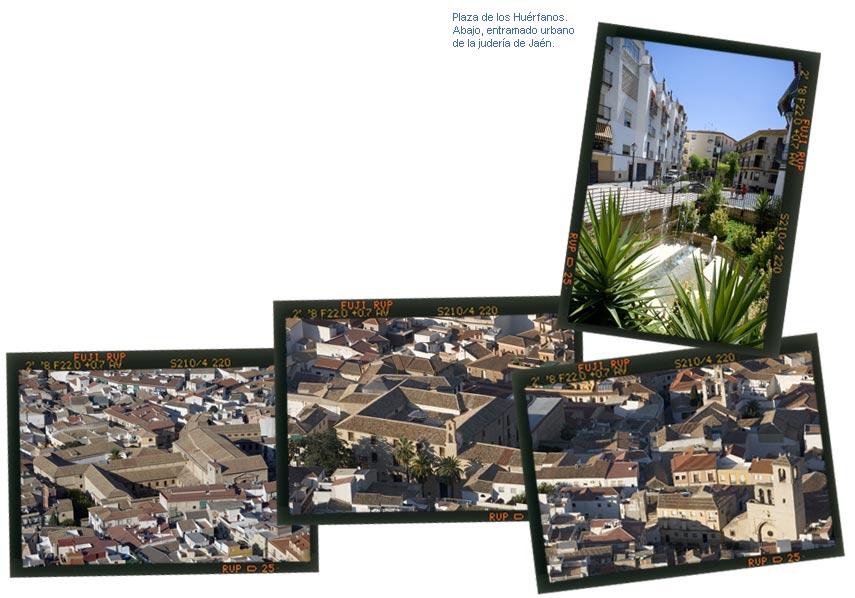
3
OUT OF THE JEWISH QUARTER. FROM SANTA LUISA SQUARE TO MAGDALENA’S SQUARE
Retracing our steps, we return from San Andrés Street to Martínez Molina, then we continue until we reach Santa Luisa de Marillac Square, popularly known as “Plaza del Pato.” In this square we can discover the evocative old palace of Fernando Torres de Portugal, who was the viceroy of Peru´s and Villardompardo´s Count. It is a Renaissance building, built on the remains of the old Arab baths of the 11th century. The inside of the palace is well worth a visit, because it houses the interesting Museum of Popular Arts and Traditions, the international Naïf Museum, and especially the old Arab Baths that are situated under the palace and whose refurbishment works won the “Europa Nostra” prize in 1984. The hammam or Arabic Bath was used alternatively by women and men. It was also sometimes used by the different religious people that inhabited the Hispano-Muslim or Castilian city. The Jewish population used the Bath on Thursdays because it was the Holy Day of Obligation for Islamic people and the previous day of the Jewish Shabbat. The Shabbat was a day devoted to prayer and study. There is historical evidence that another Arabic Bath existed in Jaén at the same period of Villardompardo’s palace and it was owned by a Jewish man. The name of the bath, “Hammam ibn Ishaq” means “Isaac’s son´s Bath.” This Bath was located in the proximity of San Andrés church; the reason being that this church was a possible synagogue in the past. A promotion of the archaeological remains of the Bath is planned in the near future. During the middle ages it was usual to find hammam baths within the Jewish quarters. If we walk along Santo Domingo Street, in fifty metres we reach the building of the Royal Monastery of Santo Domingo, where the Court of the Inquisition was located; this Court was very closely linked to the Jewish history of the city. During the first fifty years of the Inquisition the main objective was to control and persecute the Jewish converts. A special mention should be made of the magnificent cloister, which is said to be the best in the province, and of the church, which is currently undergoing restoration. Continuing along the same street about hundred and fifty metres we come across Magdalena Square. This parish church preserves the remains of an old Shan or ablution’s courtyard because this church was a mosque during the Muslim period when Jaén was called Yayyan. In the same square we can see a building with porches, which is traditionally thought to be the remains of the old Cadí’s house. Quite close to Magdalena’s Fountain, traditional tales locate the place where the house of “Ibn Shaprut” was situated (it was one of the most important Jewish families of the period). In the house, even today, there is a “Maguen David” (Jewish Star of David). According to the aforementioned traditional tale, in this place stood the residence of this family, where Hasday Ibn Shaprut, the famous Jewish courtier lived during his childhood. He was born in Jaén, and was one of the most important personalities in the Jewish period of the country and symbolizes the Golden Age of Spanish Judaism. He was a wise man, patron of culture not only in Jaén but far beyond the borders of Al-Andalus, promoter of the Hebrew Philology School in Córdoba, co-translator of the medical treaty of Dioscórides (with the help of a Byzantine monk), he re-discovered a poisonous antidote called “triaca” and was the personal doctor of Caliphs Abderramán III and Al-Hakam II and of King Sancho el Craso de León. Furthermore, he was the head of Customs in Andalusia and secretary of Latin letters, amongst others positions. He was a multi-faceted person and had a very interesting life full of experiences. In fact, he was called the “Prince of the Jews of Al-Andalus,” this appellation allowed him to establish contact with foreign emperors and kings and become the bastion of the international Jewish Community. His father was a wealthy Jewish man of Jaen, who defrayed the construction of a synagogue and had one of the most important Hispanic-Jewish poets of the period as his secretary, Menahem Ben Saruq, who probably lived in the city too. Very close to this house, on the same side of the street and in front of the main façade of Magdalena’s Church we can find Magdalena’s Fountain. It is a millennial spring which, according to tradition, inhabited the legendary lizard of Jaen, “Malena’s Lizard.” According to the
popular legend, an enormous snake or dragon had frightened the population for a long time until the day that a brave shepherd killed him with a well-planned trick, making him eat an explosive substance that exploded with an enormous blowout, which still remains in the collective memory of the city. It is the Mediterranean myth of the dragon, in a local legend that, according to some scholars, has Indo-Mesopotamian origins and stays true to the original version. Probably, the first explorers and Syrian-phoenician or even Jewish merchants brought the legend to Jaén. This legend is catalogued as one of the 10 treasures of the Intangible Cultural Heritage of Spain and it is also a candidate to be declared as a World Intangible Cultural Heritage by UNESCO. From this square the visitor is invited to continue exploring the city by visiting Santa Catalina’s Castle, which is located on a hill with the same name and houses an interesting Tourist Interpretation Centre, a beautiful National Parador and has wonderful views of the town from the Cross. If you have time during the tour, do not hesitate to visit other monuments and places of interest within the city, especially the provincial museum, which has a Hispanic-Muslim room where the visitor can admire a possible Jewish pointer (yad) for the reading of the Torá (Jewish law scrolls), and a Kabbalah’s charm with Hebrew inscriptions with an effigy of Jesus Christ in the middle which symbolizes the cultural mixture of the city. In this museum you can discover a vast amount of outstanding pieces, such as the Iberian sculpture collection, one of the most important of the country. Whatever option you choose, remember that the Jewish people of Jaén were walking in the same streets and olive groves that we can see in front of us today. Jaén was one of the places “onde los sefardim moraban” (where the Sephardic lived), and still today, there are Sephardic families that still preserve the Jewish traditions of Jaén, for example the D’Jaen, Djaen, Kaen or Marrache families. There are families and individuals that still return to their ancestral land searching for identity. At the same time, Jaen’s current inhabitants can identify themselves as descendants of those Jews who converted to Christianity and represented about 10% of the local population in the 15th and 16th centuries.
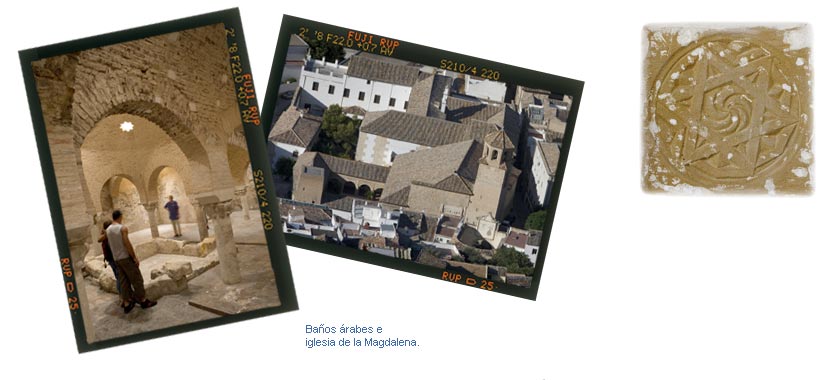
Documentos
